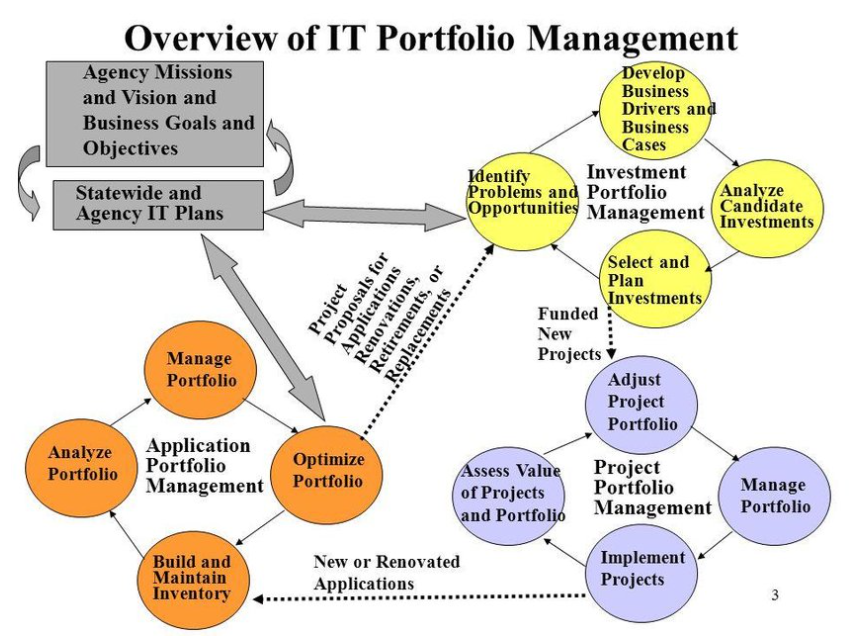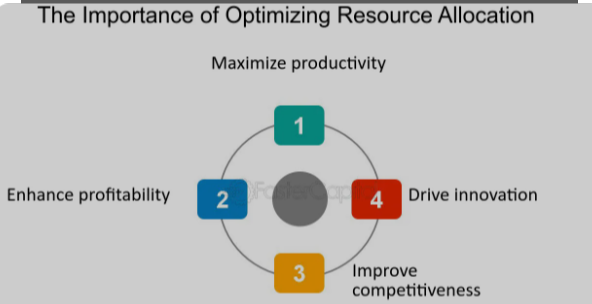It’s a matter of fact that IT Portfolio Management is important for managing IT investments and aligning them with business goals. Typically, it requires the following things:
- Careful IT planning
- Financial management
- Risk management
This helps to get the most value from IT infrastructure and manage IT services effectively. Generally it’s important as it gives a complete view of the organization’s technology.
Best practices include having a strong enterprise architecture, and investment management strategies.
Introduction to IT portfolio management
There is no denying that IT Portfolio Management is a strategy that aligns IT investments with business goals. It involves important aspects like IT financial management. What’s interesting is these help the organization’s IT infrastructure evolve to support the business strategy.
It’s well known that portfolio management helps in managing IT services, aligning strategies, etc. to get the most value from IT investments. It includes risk management and demand management too.
Definition and overview of IT portfolio management
It’s obvious that IT Portfolio Management is about strategically managing IT investments, assets, infrastructure, and the financial aspects of projects to achieve business goals. It focuses on a company’s IT strategies, like risk management to align IT services and investments with business goals.

Usually this method involves collecting and maintaining a portfolio of the company’s-
- IT services
- Applications
- Assets
Plus, it uses principles from investment portfolio management to manage and optimize IT strategic alignment so that it can achieve business goals.
The role of IT portfolio management in agencies
One thing is for sure: IT Portfolio Management is important in agencies. The reason for this is it aligns IT investments with business goals. Obviously it helps in IT financial management by efficiently managing investments and optimizing IT assets and resources. Typically, it also ensures good IT governance.
By prioritizing IT service management, it also improves the reliability and feasibility of the IT infrastructure. What’s amazing is through effective demand management, it contributes to IT planning by balancing the demand and capacity of IT resources.
The role of Bonsai project management in agencies
.webp)
Agencies benefit from Bonsai's ability to automate administrative tasks, facilitate effective communication, and ensure smooth workflow transitions. Bonsai project management plays a transformative role in agencies by streamlining workflows and enhancing productivity. It provides a centralized platform for managing client briefs, creative solutions, and project timelines.
The importance of IT portfolio management
It’s crucial to realize that IT portfolio management is important in optimizing IT investments.
Notably, it provides a structured approach to IT planning, allowing organizations to align their strategies, and control risks that improve the overall enterprise architecture.
Usually, key benefits include:
- Effective investment management in IT assets and infrastructure
- Superior risk management and demand management strategies
- Enhanced project and program management
- Strengthening strategic alignment
It’s just fascinating how IT portfolio management helps in maximizing returns while minimizing risks!
Aligning IT investments with business objectives
It’s an undeniable truth that aligning IT investments with business objectives is crucial for organizational success. Good IT governance allows companies to prioritize their IT infrastructure. Essentially, effective IT planning and IT financial management provide insights into IT expenses, helping to justify investments.
It’s significant to note that enterprise architecture provides a plan on, “How to use and manage IT assets and resources to support the overall business strategy?”
Risk management ensures proper measures are in place to protect against challenges and threats that can impact IT investments.
Interestingly, investment management, including portfolio and program management, is essential in overseeing the performance of IT projects. The good news is it aids in making prudent decisions along with ensuring resources are optimized.
Optimizing resource allocation
It’s worth noting that the main goal of optimizing resource allocation is to align strategy and manage IT finances efficiently. Obviously, this involves looking at all IT assets and investments.
Here are the benefits of efficient use of resources:
- Improves risk management
- Enhance IT governance
- Proactive IT service management
What’s fascinating is that the key activities are planning for future IT projects and programs, and managing demand to match IT resources with the needs of the organization.

Managing risks and enhancing decision making
One thing is for certain: Implementing an enterprise architecture leads to better decision-making. Inarguably, it gives a complete view of the organization’s IT infrastructure and assets. Portfolio management and IT planning also help prioritize IT projects that enhance investment management as well as policy effectiveness.
Moreover, implementing an enterprise architecture gives a complete view of the organization’s IT infrastructure and assets. Undoubtedly, portfolio management and IT planning also help prioritize IT projects.
Key components of IT portfolio management
One thing is for sure: IT Portfolio Management is a key process for businesses to get the most out of their IT investments. The main components are-
- Strategic alignment
- Risk management
- IT financial management
What’s more is these components aim to provide a balanced portfolio that supports the enterprise architecture as well as IT governance in the company.
Project portfolio
It’s a matter of fact that the project portfolio is a group of projects and programs managed together to achieve strategic goals. The portfolio shows a snapshot of all IT investments in an organization. Usually, the key aspects of this section are IT financial management, IT governance, and enterprise architecture.

Application portfolio
There is no denying that the Application Portfolio section is about a company’s managed IT investments. It includes portfolio management, which looks after all parts of a company’s IT assets and infrastructure. It also includes project and program management.
It’s well known that the Application Portfolio also includes parts of IT service management and enterprise architecture. Undoubtedly key processes like IT planning, and investment management are all vital for success. It’s surprising to find out how it also includes IT governance and IT financial management for better control over resources!
Infrastructure portfolio
It’s obvious that our Infrastructure Portfolio is about aligning IT investments with business goals and managing risk to ensure safe and efficient operations. This framework emphasizes IT financial management, which guides the effective use of resources.
Typically, major activities include IT governance, for proper controls and procedures; IT service management, to maximize customer value. What’s obvious is we focus on demand management to align resources with business needs and program management to coordinate various projects.
In addition, portfolio management, IT assets etc. are thoroughly planned in our portfolio for optimal use. The great thing about such organized IT planning is it helps us navigate a constantly changing industry landscape.
Best practices for effective IT portfolio management
It’s no secret that effective IT portfolio management requires aligning IT investments with enterprise architecture and business goals. This includes IT planning for current and future IT infrastructure needs along with coordinating demand management with project and program management.
It’s crucial to be aware that transparent IT governance, which provides oversight of IT assets, and comprehensive risk management are essential to this process.
Establishing a governance structure
It comes as no surprise that to set up a good IT governance structure, we need to combine strategies for IT financial management, risk management, etc. These strategies help make IT investments efficient.
It’s beyond dispute that the governance structure needs a clear enterprise architecture to manage IT assets and infrastructure. Essentially this helps in managing demand effectively, ensuring good project and program management.
Regularly reviewing and updating the portfolio
It’s indisputable that regularly reviewing and updating your portfolio is crucial for IT governance and portfolio management. Notably, this involves keeping an eye on IT investment and aligning with broader business goals. What’s more is it also includes managing risks to make sure any threats to IT assets are identified and dealt with in time.
It’s an undeniable truth that the IT financial management process is important in this review, making sure any changes or updates in the IT portfolio make financial sense. It’s astounding how demand management helps identify when updates or replacements are needed in the portfolio! Regular portfolio reviews and updates are key parts of IT service management.
Implementing a balanced scorecard approach
One thing is for sure: The Balanced Scorecard approach can be very useful in IT governance. Customarily, it aids in aligning strategies and promotes efficient IT service management.
By prioritizing IT investments, we can make sure they align with business goals. As a result, it assists in creating an effective enterprise architecture. This approach has several benefits, including better risk management for IT assets and infrastructure. At the same time, it helps manage investments within the scope of IT portfolio management.
Challenges in IT portfolio management
It’s crucial to be aware that IT Portfolio Management comprises:
- Planning IT investments
- Aligning with the organization’s enterprise architecture
But it faces several challenges. It’s a very worrying thing that the complexity of IT financial management makes it hard to properly value and track IT assets and infrastructure, which can lead to poor decision-making. Sadly, effective IT governance is also challenging because of a lack of understanding of IT processes.
Dealing with complex IT environments
It’s interesting to point out that managing complex IT environments requires strategic alignment, efficient IT service management, etc. This involves the following things:
- Accurate planning of IT assets and investments
- Implementation of effective IT governance
This not only helps optimize IT infrastructure and services but also contributes to overall project and program management.

It’s a matter of fact that risk management is another important part of dealing with complex IT systems. The good news is it helps reduce the uncertainties associated with IT financial management.
Overcoming resistance to change
There is no denying that overcoming resistance to change in IT is important. Typically, it involves several strategies. Strategic alignment should be achieved by showing that changes are necessary for business growth, which could help gain support.
A strong IT governance system is key to ensuring smooth transitions. It's staggering how it can help overcome resistance by clarifying roles and responsibilities!
It’s well known that demand management can also help overcome resistance to change. Notably this involves accurately anticipating along with responding to changes in demand for IT services. IT financial management is crucial in this process, highlighting the potential cost savings and ROI of changes.
One thing is for sure: Risk management strategies are important in reducing concerns about change. This involves identifying and addressing potential issues before they become a problem.
Tools for IT portfolio management
It’s obvious that IT Portfolio Management tools are important for managing an organization’s IT investments and infrastructure. Usually, they help with IT financial management by evaluating the return on investment of different IT assets and prioritizing investments.

It’s surprising how these tools have features like project and program management capabilities! This allows for efficient management of many different IT projects. Plus, they also support enterprise architecture and risk management. One thing to note is that they also help with IT governance by monitoring user needs, and ensuring the best IT service management. As a consequence, IT Portfolio Management tools play a key role in investment management.
Planview PPM Pro for comprehensive portfolio management
It’s no secret that Planview PPM Pro helps organizations get the most out of their IT investments and optimizes IT financial management. This tool makes IT planning, investment management, and risk management as easy as pie!
To add on, it aligns strategies across the enterprise architecture and has features like-
- Advanced IT governance
- Integration with existing IT service management systems
- Demand management capabilities
Planview PPM Pro also provides unmatched visibility into IT assets and infrastructure.
ServiceNow IT business management for streamlined operations
It comes as no surprise that ServiceNow IT Business Management uses an efficient approach to manage IT investments along with IT financial management.
By using enterprise architecture, it ensures strategic alignment. Interestingly, this module helps businesses balance their need for innovation with their requirement to maintain and improve the IT infrastructure.
It’s well known that ServiceNow ITBM not only helps with demand management and project management but also enables effective program management and investment management. This optimizes IT governance, ensuring better control over IT assets.
Cherwell IT service management for enhanced service delivery
There is no doubt that Cherwell IT Service Management promotes strategic alignment and leverages IT investments for better service delivery. Generally, it supports enterprise architecture and IT governance by providing a comprehensive solution that streamlines IT service management together with IT financial management. This enables organizations to carry out their IT planning efficiently and effectively.
It’s worth noting that the risk management aspect is well integrated in Cherwell’s ITSM solution. This enables organizations to anticipate and mitigate potential threats. It also optimizes demand management, investment management, and program management. Undoubtedly, Cherwell’s sophisticated solution transforms service delivery, ultimately improving business performance.
Conclusion: the future of IT portfolio management
One thing is for certain: IT Portfolio Management will be shaped by rapid advancements in technology and the growing importance of IT governance. As organizations strive for strategic alignment, understanding IT investments and effective project management will be critical.
It’s crucial to realize that in addition, robust IT service management will become even more important to ensure efficiency in IT infrastructure. Interestingly, aspects like IT financial management, and demand management are expected to become central in enterprise architecture along with IT planning.
It’s fascinating to find out how Advancements in AI, machine learning, and data analytics are also set to redefine portfolio management! At the same time, it will offer new opportunities, but also new challenges.







